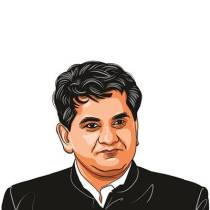No trade-offs in healthcare
Pradhan Mantri Jan Arogya Yojana will catalyse changes in the health sector. It is not a substitute for a foundation built on primary care.

Since its launch on September 23, it has already benefitted close to 2,00,000 people.
Ayushman Bharat-Pradhan Mantri Jan Arogya Yojana (PM-JAY) is the most ambitious health sector scheme since Independence. Prime Minister Narendra Modi has himself led the process. If implemented well, PM-JAY could dramatically change the picture of the health sector and directly benefit more than 50 crore poor people. Since its launch on September 23, it has already benefitted close to 2,00,000 people.
A mission of such scale and ambition is bound to attract considerable public scrutiny. The discussion on PM-JAY is, therefore, welcome. Commentators (including K Sujatha Rao in “Insurance, false assurance,” IE, October 31) have raised several concerns about the scheme. We seek to address them.
Critiques of the scheme usually stem from the following five concerns. One, PM-JAY focuses on secondary and tertiary care, taking away the attention from primary care and public health-related investments. Two, in a supply-deficit environment, raising demand will not help. Three, the current package prices are too low to encourage private-sector hospitals to fully participate in the scheme. Four, hospital insurance addresses only a small amount of out-of-pocket expenditures. Finally, there is scepticism that either the required budget will not be available or provided at the expense of other critical needs.
There is no disagreement that strong primary care and effective public health interventions should be solid foundation of the health system. The health and wellness centres component of Ayushman Bharat seeks to ensure exactly that. However, irrespective of how effective and well-funded our primary healthcare system is, a large number of poor people will need secondary and tertiary care. Currently, they don’t have much choice when they fall seriously sick. Without PM-JAY, either they would delay or avoid seeking treatment, or sell their assets or borrow heavily to fund such care. There is no trade-off between investing in primary and preventive health for the general population and supporting curative health for the poor.
It is correct that the supply of quality healthcare is constrained in the country relative to international norms. We have only 1.3 beds per 1,000 people as compared to the WHO norm of five beds. However, even this limited supply disproportionately serves the non-poor section of the population. More than 80 per cent of hospital beds are in the private sector, yet the poorest 40 per cent can’t afford quality private healthcare. PM-JAY will increase access to both public as well as private sector services.
Where will the incremental supply of beds come from to support the anticipated increase in demand? In the short run, it will come from the spare capacity in the private sector as well as from the more efficient use of existing capacity. Private sector hospitals have an occupancy rate of 60-70 per cent. Improvement in efficiency and greater use of home-based care will release some constraints. In the medium-term, the market should respond through expanded private sector capacity in Tier 2 and Tier 3 cities. With significantly greater paying power due to PM-JAY, and government incentives for the private sector and PPP operations, the private sector’s supply of quality services is bound to expand. Over the last decade, approximately 1 lakh hospital beds have been added annually but this will need to increase by almost 1.8 times if we are to reach the target of 3.6 million beds by 2034. PM-JAY will catalyse these changes.
Package rates under PM-JAY have been fixed conservatively with a view to improve the scheme’s sustainability. We have also considered the large volume of business that the scheme will generate, creating economies of scale. States like Gujarat, Karnataka, Maharashtra and Tamil Nadu, where some schemes are already in operation, have been allowed to continue with their existing rates. The government is open to modifying the rates, when supporting evidence becomes available.
Some commentators point to the lack of evidence to show that government-funded health insurance schemes reduce out-of-pocket expenditure on healthcare. However, international experience goes against this argument. For example, when China embarked on reforms towards universal health coverage in 2007, out-of-pocket spending was around 60 per cent of the country’s health expenditure. It has come down to 30 per cent now. It is correct that there is no national-level evaluation of government-funded health insurance schemes in India. One study of Karnataka’s scheme did show a significant reduction in out-of-pocket spending for healthcare.
We also need to understand the intention behind PM-JAY. With a budget in the range of Rs 10,000-12,000 crore per year, it can realistically be expected to have only limited impact on overall out-of-pocket spending levels on healthcare, which amounts to around Rs 2,40,000 crore. However, PM-JAY will certainly have a significant impact on reducing the out-of-pocket spending incurred on the catastrophic health expenses by the poorest 40 per cent of the population.
Finally, the finance minister has assured Parliament about fully funding PM-JAY, and linked it with the newly-introduced health cess. In addition, public resources for the health sector are likely to expand significantly. The government has committed to increasing spending on health from the current 1.2 per cent of the GDP to around 2.5 per cent in the next seven years.
Our country has a long way to go in reducing the high out-of-pocket expenditure on health, expanding access to quality health services for the poor, and improving the affordability and quality of health services. Only time will tell if PM-JAY will succeed in achieving these objectives. However, we know that the approach followed in the last 70 years did not work. Let us give PM-JAY a chance.
Kant is CEO, Niti Aayog and Bhushan is CEO, PM-JAY






































No hay comentarios:
Publicar un comentario